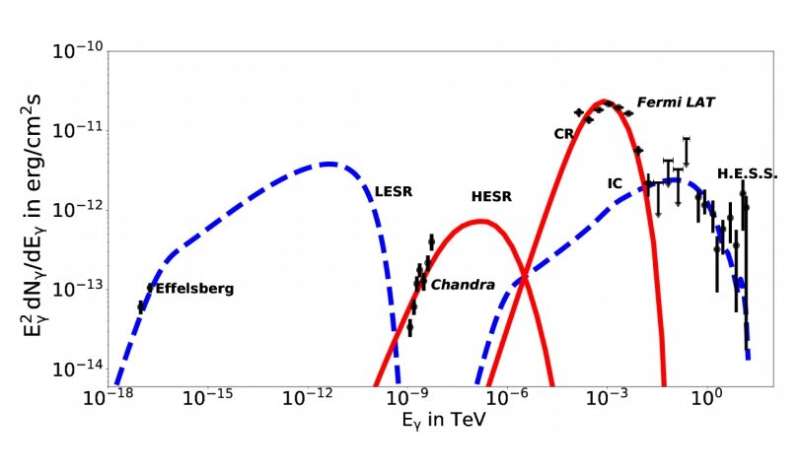June 3, 2019 report
Fermi observations provide insights into the nature of Terzan 5 globular cluster

Using NASA's Fermi Gamma-ray Space Telescope, astronomers have collected important data that could disclose the real nature of the globular cluster Terzan 5. The new study, presented in a paper published May 24 on arXiv.org, delivers new information regarding the cluster's pulsar population and its broadband emission spectrum.
Observations of globular clusters (GCs) in our Milky Way galaxy are of high importance for astronomers as they are among the oldest objects in the universe. Therefore, they could serve as natural laboratories for the study of stellar evolution processes.
Discovered about a half-century ago, Terzan 5 is a 12-billion-year-old galactic GC located some 19,000 light years away. The cluster has a particularly high central stellar density, high metallicity, and also the highest stellar interaction rate of all GCs in the Milky Way.
Terzan 5 is known to host 37 out of 130 millisecond pulsars (MSPs) detected so far, what makes it a record holder when it comes to the largest number of MSPs in a galactic GC. Previous studies of this cluster have also shown that it contains at least two distinct stellar populations with different ages and iron content. This could suggest that Terzan 5 may not be a "true" globular cluster, but a result of a merger of two clusters, for instance, or a remnant of a disrupted galaxy.
In order to get more detailed information about Terzan 5, which could verify these possibilities, an international team of astronomers led by Hambeleleni Ndiyavala of North-West University in Potchefstroom, South Africa, decided to analyze new data obtained by the Fermi spacecraft. This dataset allowed the researchers to model the broadband spectral energy distribution (SED) in the cluster.
"We therefore aimed to gather more data on Terzan 5 and model the updated SED in a leptonic scenario," the astronomers wrote in the paper.
In particular, the spectral model described in the study postulates four spectral components, namely: low-energy synchrotron radiation (LESR), high-energy synchrotron radiation (HESR), curvature radiation (CR) and inverse Compton (IC). The model also allowed the astronomers to constrain the MSP population's distribution of spin-down luminosity.
According to the study, the updated SED in Terzan 5 is most likely due to a cumulative pulsed emission from a population of embedded MSPs. Moreover, it could be as well attributed to unpulsed emission from the interaction of leptonic winds with ambient magnetic and soft-photon fields.
"We obtained new Fermi data that we could fit using a model for the cumulative CR from a population of MSPs embedded within Terzan 5. These data also proved to be constraining for the low-energy tail of the unpulsed IC component, yielding a particle efficiency of ηp~3 percent, depending on the choice of several parameters, notably〈 ̇Evis〉and NMSP,tot," the paper reads.
In concluding remarks, the astronomers underlined the importance of further studies of Terzan 5 and similar clusters to get a more comprehensive view on the nature and properties of galactic GCs in general. They added that such instruments like the Cherenkov Telescope Array (CTA) could be much helpful in identifying new very-high-energy (VHE) GCs.
"This will allow us to further scrutinize competing emission models, as well as developing new, more complete and comprehensive ones that might explain the spatial and spectral properties of galactic GCs at an ever increasing level of detail," the authors of the paper noted.
More information: Hambeleleni Ndiyavala, et al. Probing the pulsar population of Terzan 5 via spectral modeling. arXiv:1905.10229v1 [astro-ph.HE]: arxiv.org/abs/1905.10229
© 2019 Science X Network


















